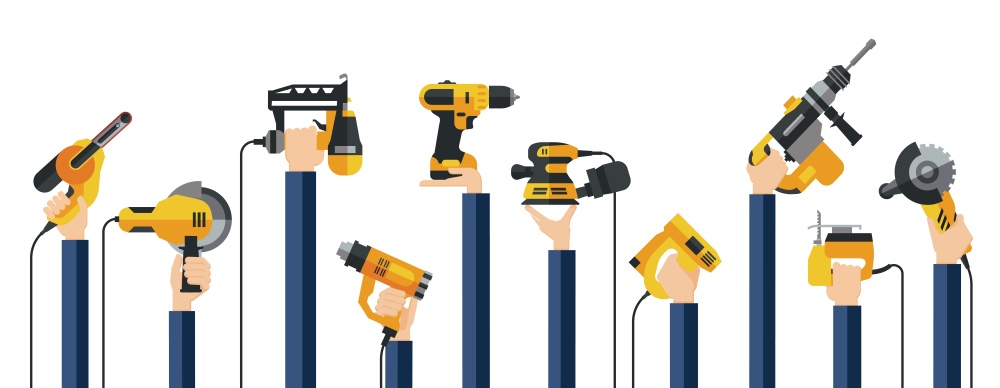Woodworking is a serious craft that requires hours of effort and real perseverance. Whether for making furniture or just for learning something new, you would need the right set of tools to master the techniques. However, for a beginner, things can get a little bit messy. So, if you want to learn woodworking but don’t know where to start from, this is the right place for you! Don’t feel intimidated by the long Basic Woodworking Tools list though. Once you start working your way round these tools, woodworking will be a piece of cake.
My Basic Woodworking Tools List
Most professionals actually prefer using hand tools for most techniques rather than power tools, because it gives them absolute control over the work. Say you want to make a cabinet, but your budget cannot incorporate power tools. In that case, hand tools are your best bet. At some point, you’ll even start building your own collections! You don’t have to have every item, but if you are keen to go that far, then you should follow this woodworking hand tools list.

Saws And Sawhorse
Saws are extremely crucial for woodwork. The most common types are called hand saws, which are used to cut into wood and through grain. You will need the hand saw to create dimensions in the wood. While using your hand for sawing you could actually feel the effect of the blades and how the wood is responding. Once you master the hand saw, you will soon have a collection of various types, such as fretwood saw, rip saws and cross-cut saws.
Back saws are needed to make accurate joints. These also come in various types. Carcass saw can cut across the grain, while the dovetail saw cuts along the grain. Tenon saw can be used to make deeper cuts.
Last but not the least, you will need a coping saw if you want intricate patterns in your wood. Such patterns cannot be done by large saws. Coping saw can fix rough awkward shapes and even remove waste from joints made by dovetail saws.
For any work involving saws, you will need a sawhorse. It is more like a workplace extension, which provides support for drilling and sawing. You can even build one yourself if you’re up for it!
Claw Hammer
A carpenter cannot do without one of these! The claw is used to remove nails. The handle maybe rubber or vinyl; get a claw hammer with a grip suitable for you. The solid hammer head is used to push in nails.
Chisels
An absolute must, chisels are of two types. The normal type could come in 4 different sizes, which are used to refine edges, smoothen cuts and joints and clean mortices. Chisels are needed for carving out wood. Mortice chisels are slightly more specialized. These are used to simply chop mortices for tenon insertions.
Planes
For basic woodworking, you will need two types of planes. The block plane is required to trim and flatten lumber, shape and add curves to your work, leveling or squaring, removing sharpness and so much more. Remember to sharpen the blade before work. The jack plane can be used to smoothen the board and edges. Smoothing planers are used to produce a neat fine finish.
Spirit Level And Combination Squares
To make something perfectly horizontal or vertical, you will need a spirit level. The level uses bubbles which indicate how straight something is. Spirit levels could be found in many sizes. To get perfect right angles or 45?, or measuring any other existing angles, combination squares are required. The set comes with a ruler for accurate measurements.
Mallet
While using chisels to cut and refine joints, use a mallet instead of a hammer. You’ll need it to hit the chisels.
Marking Knife, Gauge, And Pencils
Pencils are definitely needed for initially drawing the desired shape, but most carpenters agree that the real fun is marking the shapes with a marking knife. The knife is a good alternative for many people and provides better accuracy. With a marking gauge, you can mark tenons, mortices, and joints.
Workbench
Where would you do all the work and maneuver your lumber? You cannot just work in any random space; you should have a workbench. You can make your own or buy a professional one. Either way your woodworking practice will become a lot easier if you have a workbench where you can work peacefully with all tools at arm’s length.
Calipers And Clamps
Calipers are essential tools, which you could use to measure diameters, width and depth and thickness of various chunks of wood attached to flat regions. They can finely trim wood. When you glue pieces of wood or joints, you might need several clamps to hold them together, so that pressure is applied appropriately in areas where it is needed.
Must-have Power Tools

At some point, when you are done collecting hand tools and have pretty much got into woodworking, you would want to speed things up. Using hand tools also require a lot of effort and can get tiring and boring very easily. To save time and still remain accurate, or to simply move on to the professional level, you would need power tools. A woodworking tools list is incomplete without the mention of power tools. However, we didn’t put some specific tools like wood lathes and the likes in the list to keep it short. Let’s check out some of the most basic power tools that you can start with.
Power Drills
Any furniture making process is incomplete without a drill. You should have a power drill to make holes where you can fit in screws. Drills may be cordless or may come with a cord. Pick the type you are comfortable with. Although cordless ones are easier to handle, they are also expensive and lose charge easily. Corded power drills are preferred by woodworking hobbyists.
Jigsaw
To make curves, intricate details and plunge cuts with high control and accuracy, a jigsaw is your best bet. Jigsaws are versatile and offer a variety of uses, for example, they are used to make small holes for plugging in cabinets.
Power Planer
This planer could even the surface of your lumber by shaving away extra wood from the surface. It is usually used when the sawing has been done too much compared to the sanding. Instead of the hand planers mentioned above, you can use a power planer to do work faster and more efficiently. This tool can also be used to strip layers of varnish or paint from furniture.
Random Orbital Sander
This is an innovative tool that can help you avoid flaws in your sanding techniques. It uses sanding disks to remove unwanted patterns. The disks rotate in a random motion while sanding, hence the name. A random orbital sander reduces marks on the wood. Palm sanders are less expensive and produce the same effect, but work differently. A palm sander uses sandpaper moving in normal motion, rather than discs, which makes it simpler. On the other hand, a belt sander uses a pair of drums mounted by sandpaper loop.
Router
Routers are versatile and are a favorite among woodworking enthusiasts. Its spinning bit is used to develop shapes, finish edges, create holes and contours, make grooves and slots for bevels, mortices, dados, etc. Plunge routers can be used to create plunge cuts in however depth you want. For safety, it is best to mount routers to router tables, which could also simply become an extension to your workbench.
Woodworking requires a great amount of effort, time and creativity, but it also gives a satisfactory amount of pleasure when you see your work come to life. Although hand tools are mostly used by most professional woodworkers, to save time and effort, power tools are also essential. Keeping a collection of hand tools is the basic requirement for any woodworking enthusiast, but for safety and efficiency in work, the tools should be upgraded whenever needed. An even better idea is to do woodworking with a partner. This way you will not be bored and even collaborate into making more innovative items! Share the Basic Woodworking Tools list with your partner or group and gather up the necessary tools, and pour your effort into making things straight out of wood. Before you know it, you will love and appreciate woodworking.








